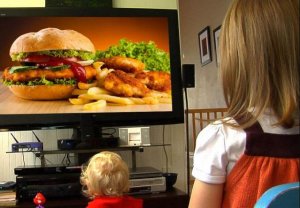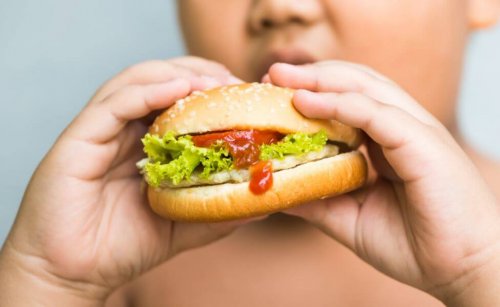Should We Control the Advertising of Junk Food?

Advertising of junk food should be controlled, because food and beverages with a high sugar and salt content have an immediate and significant health impact on the consumer. This particularly applies to children, because advertising of junk food encourages them to adopt harmful diets.
In recent times, childhood obesity has skyrocketed. To some extent, advertising and the publicity it bombards us with, leads us to eat foods that are high in unhealthy fats. Hence, the importance of controlling junk food advertising.
In 2013, Mexico prohibited advertising junk food during children’s television programs. Why don’t we apply the same law in our country? We should all take responsibility for the health of the next generation.

Possibly, it has something to do with the money involved for broadcasting these adverts in the media. In the United States alone, advertisers spent more than $2,000 million last year, promoting junk food for children.
Advertising restrictions
The WHO (World Health Organization) have placed restrictions on alcohol and tobacco advertising. This applies to the media of the member states of the European Union, because many countries haven’t yet established limits regarding food advertising for children.
In Spain, one-third of children under 12 years old, are overweight. This figure soars to 46 percent for children between the ages of six and nine, according to data from the Spanish Agency for Food and Safety.
When it comes to the amount of time that people spend in front of the television, children in Spain between three and twelve years old, come second in Europe. They spend an average of two and a half hours each day, watching television.
During that time, most of the targeted advertising is from junk food products. Each child is likely to see 54 television commercials throughout the day, and 71.2 percent of these are promoting junk food that’s high in calories and sugars.
Junk food products
Most of these unhealthy products can be itemised together in groups:
1) Sugar-coated cereals: typical in breakfast products for children.
2) Sugary drinks: like soda, juices and beverages made with sweetened powder.
3) Sweet snacks: chocolates, muffins and cookies
4) Salty snacks: potato chips are packed with salt, as are some sweet products too.
5) Fast food: the typical burgers, chicken nuggets, hot dogs and fries.

It would be a healthy option to change any mid-morning chocolate-covered snacks, for a piece of fruit. We should drink more water, and not allow our children to continuously consume drinks loaded with sugar.
Buying junk food
Apart from controlling the advertising of junk food, we should also consider the stores that sell it, seeing that it’s readily available.
– Supermarkets or convenience stores: not only can we easily buy junk food here, but we also find irresistible promotions. These are often aimed at children with eye-catching packaging, that even use drawings or popular cartoons.
– Means of transportation: many vehicles display advertising, but that’s not all. You’ll often find subway stops and vending machines only stock junk food products.
– Schools: many schools and colleges have a cafeteria. Sadly, this is where most children will find fries, candies and other sugar-filled products.
Given that it’s so easy to consume unhealthy products, we must try to control the advertising of junk food and encourage sales of fruits and healthy snacks. This would dramatically reduce the consumption of unhealthy food.
Advertising of junk food should be controlled, because food and beverages with a high sugar and salt content have an immediate and significant health impact on the consumer. This particularly applies to children, because advertising of junk food encourages them to adopt harmful diets.
In recent times, childhood obesity has skyrocketed. To some extent, advertising and the publicity it bombards us with, leads us to eat foods that are high in unhealthy fats. Hence, the importance of controlling junk food advertising.
In 2013, Mexico prohibited advertising junk food during children’s television programs. Why don’t we apply the same law in our country? We should all take responsibility for the health of the next generation.

Possibly, it has something to do with the money involved for broadcasting these adverts in the media. In the United States alone, advertisers spent more than $2,000 million last year, promoting junk food for children.
Advertising restrictions
The WHO (World Health Organization) have placed restrictions on alcohol and tobacco advertising. This applies to the media of the member states of the European Union, because many countries haven’t yet established limits regarding food advertising for children.
In Spain, one-third of children under 12 years old, are overweight. This figure soars to 46 percent for children between the ages of six and nine, according to data from the Spanish Agency for Food and Safety.
When it comes to the amount of time that people spend in front of the television, children in Spain between three and twelve years old, come second in Europe. They spend an average of two and a half hours each day, watching television.
During that time, most of the targeted advertising is from junk food products. Each child is likely to see 54 television commercials throughout the day, and 71.2 percent of these are promoting junk food that’s high in calories and sugars.
Junk food products
Most of these unhealthy products can be itemised together in groups:
1) Sugar-coated cereals: typical in breakfast products for children.
2) Sugary drinks: like soda, juices and beverages made with sweetened powder.
3) Sweet snacks: chocolates, muffins and cookies
4) Salty snacks: potato chips are packed with salt, as are some sweet products too.
5) Fast food: the typical burgers, chicken nuggets, hot dogs and fries.

It would be a healthy option to change any mid-morning chocolate-covered snacks, for a piece of fruit. We should drink more water, and not allow our children to continuously consume drinks loaded with sugar.
Buying junk food
Apart from controlling the advertising of junk food, we should also consider the stores that sell it, seeing that it’s readily available.
– Supermarkets or convenience stores: not only can we easily buy junk food here, but we also find irresistible promotions. These are often aimed at children with eye-catching packaging, that even use drawings or popular cartoons.
– Means of transportation: many vehicles display advertising, but that’s not all. You’ll often find subway stops and vending machines only stock junk food products.
– Schools: many schools and colleges have a cafeteria. Sadly, this is where most children will find fries, candies and other sugar-filled products.
Given that it’s so easy to consume unhealthy products, we must try to control the advertising of junk food and encourage sales of fruits and healthy snacks. This would dramatically reduce the consumption of unhealthy food.
All cited sources were thoroughly reviewed by our team to ensure their quality, reliability, currency, and validity. The bibliography of this article was considered reliable and of academic or scientific accuracy.
- Aesan – Agencia Española de Seguridad Alimentaria y Nutrición. (2019). Estudio Aladino. Retrieved December 10, 2022, from Gob.es website: https://www.aesan.gob.es/AECOSAN/web/nutricion/detalle/aladino_2019.htm
- Arie, S. (2019). WHO calls for more action to protect children from online junk food advertising. BMJ (Clinical Research Ed.), 364, l1221. doi:10.1136/bmj.l1221
- González Díaz, C. (2014). La publicidad dirigida a niños en el sector de la alimentación: un estudio atendiendo al tipo de producto. Historia y comunicacion social, 18(0), 175–187. doi:10.5209/rev_hics.2013.v18.44235
- Organización Mundial de la Salud (OMS). Obesidad y sobrepeso. (n.d.). Retrieved November 23, 2022, from Who.int website: https://www.who.int/es/news-room/fact-sheets/detail/obesity-and-overweight
- Pérez Ornia, J. R., & Coaut, N. L. L. (2003). Programación infantil en la televisión española : inadecuada relación entre oferta y demanda. Retrieved from https://repositorioinstitucional.ceu.es/handle/10637/1200
- Veiga, G., & Marcos, S. (n.d.). Los anuncios de comida invaden la televisión infantil en EE UU – Rebelion. Retrieved December 10, 2022, from Rebelion.org website: https://rebelion.org/los-anuncios-de-comida-invaden-la-television-infantil-en-ee-uu/
This text is provided for informational purposes only and does not replace consultation with a professional. If in doubt, consult your specialist.








